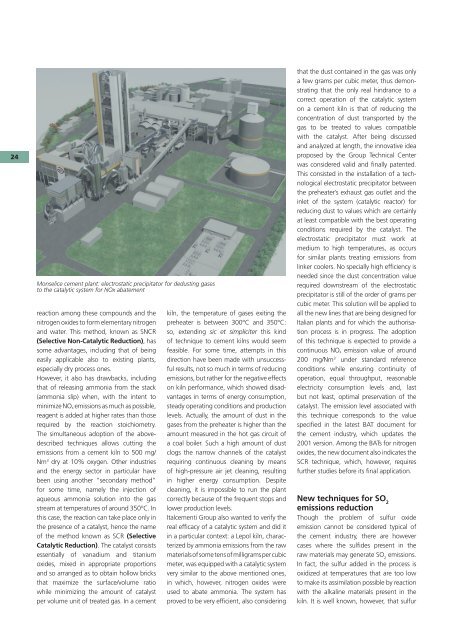SD Vision - Halyps Cement
SD Vision - Halyps Cement
SD Vision - Halyps Cement
You also want an ePaper? Increase the reach of your titles
YUMPU automatically turns print PDFs into web optimized ePapers that Google loves.
24<br />
Monselice cement plant: electrostatic precipitator for dedusting gases<br />
to the catalytic system for NOx abatement<br />
reaction among these compounds and the<br />
nitrogen oxides to form elementary nitrogen<br />
and water. This method, known as SNCR<br />
(Selective Non-Catalytic Reduction), has<br />
some advantages, including that of being<br />
easily applicable also to existing plants,<br />
especially dry process ones.<br />
However, it also has drawbacks, including<br />
that of releasing ammonia from the stack<br />
(ammonia slip) when, with the intent to<br />
minimize NOx emissions as much as possible,<br />
reagent is added at higher rates than those<br />
required by the reaction stoichiometry.<br />
The simultaneous adoption of the abovedescribed<br />
techniques allows cutting the<br />
emissions from a cement kiln to 500 mg/<br />
Nm 3 dry at 10% oxygen. Other industries<br />
and the energy sector in particular have<br />
been using another “secondary method”<br />
for some time, namely the injection of<br />
aqueous ammonia solution into the gas<br />
stream at temperatures of around 350°C. In<br />
this case, the reaction can take place only in<br />
the presence of a catalyst, hence the name<br />
of the method known as SCR (Selective<br />
Catalytic Reduction). The catalyst consists<br />
essentially of vanadium and titanium<br />
oxides, mixed in appropriate proportions<br />
and so arranged as to obtain hollow bricks<br />
that maximize the surface/volume ratio<br />
while minimizing the amount of catalyst<br />
per volume unit of treated gas. In a cement<br />
kiln, the temperature of gases exiting the<br />
preheater is between 300°C and 350°C:<br />
so, extending sic et simpliciter this kind<br />
of technique to cement kilns would seem<br />
feasible. For some time, attempts in this<br />
direction have been made with unsuccessful<br />
results, not so much in terms of reducing<br />
emissions, but rather for the negative effects<br />
on kiln performance, which showed disadvantages<br />
in terms of energy consumption,<br />
steady operating conditions and production<br />
levels. Actually, the amount of dust in the<br />
gases from the preheater is higher than the<br />
amount measured in the hot gas circuit of<br />
a coal boiler. Such a high amount of dust<br />
clogs the narrow channels of the catalyst<br />
requiring continuous cleaning by means<br />
of high-pressure air jet cleaning, resulting<br />
in higher energy consumption. Despite<br />
cleaning, it is impossible to run the plant<br />
correctly because of the frequent stops and<br />
lower production levels.<br />
Italcementi Group also wanted to verify the<br />
real effi cacy of a catalytic system and did it<br />
in a particular context: a Lepol kiln, characterized<br />
by ammonia emissions from the raw<br />
materials of some tens of milligrams per cubic<br />
meter, was equipped with a catalytic system<br />
very similar to the above mentioned ones,<br />
in which, however, nitrogen oxides were<br />
used to abate ammonia. The system has<br />
proved to be very effi cient, also considering<br />
that the dust contained in the gas was only<br />
a few grams per cubic meter, thus demonstrating<br />
that the only real hindrance to a<br />
correct operation of the catalytic system<br />
on a cement kiln is that of reducing the<br />
concentration of dust transported by the<br />
gas to be treated to values compatible<br />
with the catalyst. After being discussed<br />
and analyzed at length, the innovative idea<br />
proposed by the Group Technical Center<br />
was considered valid and fi nally patented.<br />
This consisted in the installation of a technological<br />
electrostatic precipitator between<br />
the preheater’s exhaust gas outlet and the<br />
inlet of the system (catalytic reactor) for<br />
reducing dust to values which are certainly<br />
at least compatible with the best operating<br />
conditions required by the catalyst. The<br />
electrostatic precipitator must work at<br />
medium to high temperatures, as occurs<br />
for similar plants treating emissions from<br />
linker coolers. No specially high effi ciency is<br />
needed since the dust concentration value<br />
required downstream of the electrostatic<br />
precipitator is still of the order of grams per<br />
cubic meter. This solution will be applied to<br />
all the new lines that are being designed for<br />
Italian plants and for which the authorisation<br />
process is in progress. The adoption<br />
of this technique is expected to provide a<br />
continuous NOx emission value of around<br />
200 mg/Nm 3 under standard reference<br />
conditions while ensuring continuity of<br />
operation, equal throughput, reasonable<br />
electricity consumption levels and, last<br />
but not least, optimal preservation of the<br />
catalyst. The emission level associated with<br />
this technique corresponds to the value<br />
specifi ed in the latest BAT document for<br />
the cement industry, which updates the<br />
2001 version. Among the BATs for nitrogen<br />
oxides, the new document also indicates the<br />
SCR technique, which, however, requires<br />
further studies before its fi nal application.<br />
New techniques for SO 2<br />
emissions reduction<br />
Though the problem of sulfur oxide<br />
emission cannot be considered typical of<br />
the cement industry, there are however<br />
cases where the sulfi des present in the<br />
raw materials may generate SO 2 emissions.<br />
In fact, the sulfur added in the process is<br />
oxidized at temperatures that are too low<br />
to make its assimilation possible by reaction<br />
with the alkaline materials present in the<br />
kiln. It is well known, however, that sulfur


